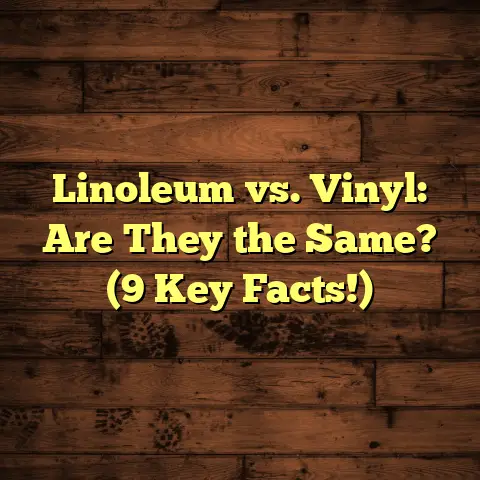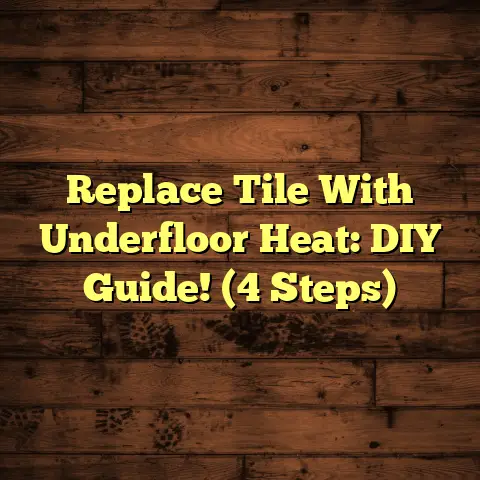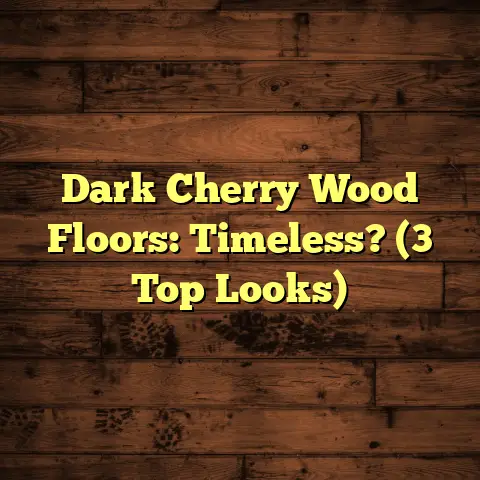Cover Tile Floors: Best Options? (8 Underlay Secrets)
Tile is fantastic – durable, stylish, and versatile. But sometimes, you just want a change, right? Maybe you’re tired of the cold, hard surface, or the style just doesn’t jive with your current vibe.
That’s where covering your tile floors comes in.
But before you jump in, there’s a secret weapon you need to know about: underlay.
Trust me, it’s not just some extra padding. It’s the unsung hero that can make or break your new flooring experience. So, grab a coffee, and let’s get started!
Section 1: Understanding Tile Flooring Trends
Tile flooring has made a huge comeback. I’m seeing it everywhere, from sleek, modern condos to cozy, rustic farmhouses.
What’s driving this resurgence? Well, tile offers a killer combo of style and practicality.
Here’s a peek at some of the hottest trends:
-
Large-Format Tiles: These big boys are all the rage. They create a clean, seamless look with fewer grout lines. I’m talking sizes like 24×48 inches or even larger!
-
Geometric Patterns: Think hexagons, chevrons, and intricate mosaics. These add a pop of personality and can instantly elevate any space.
-
Wood-Look Tiles: Get the warmth of wood with the durability of tile. Advances in printing technology have made these look incredibly realistic.
-
Natural Stone: Marble, slate, and travertine are timeless classics. They bring a touch of luxury and sophistication to any room.
Consumer Preferences and Market Stats
According to a report by MarketWatch, the global tile flooring market is projected to reach \$407.41 billion by 2028. That’s a lot of tile! This growth is fueled by increased construction activity, rising disposable incomes, and a growing demand for stylish and durable flooring options.
I’ve personally seen a huge increase in requests for tile installations and renovations in the past few years. People are investing in their homes, and tile is a key part of that.
Section 2: Reasons for Covering Tile Floors
Okay, so you’ve got tile, but you’re thinking of covering it up. Why? Here are some common reasons I hear from homeowners:
-
Aesthetic Upgrades: Let’s face it, styles change. That avocado-green tile from the ’70s might not be your cup of tea anymore. Covering it is a quick way to modernize your space without a messy demolition.
-
Comfort: Tile can be cold and hard underfoot, especially in the winter. Covering it with something softer, like carpet or LVP, can make your home feel much cozier.
-
Insulation: Tile doesn’t offer much in the way of insulation. Adding a layer of underlay and a new flooring material can help keep your home warmer in the winter and cooler in the summer, saving you money on energy bills.
-
Damage Concealment: Cracks, chips, and stains can make your tile look old and worn. Covering it is a simple way to hide those imperfections without having to replace the entire floor.
Homeowner Story
I had a client, Sarah, who had beautiful but outdated ceramic tile in her kitchen. She loved the location of her kitchen but hated the flooring.
Instead of ripping it out, which would have been a huge undertaking, we covered it with luxury vinyl plank (LVP). It completely transformed the space and gave her the modern kitchen she’d always dreamed of.
Why covering makes sense:
- Cost-effective: It’s often cheaper than demolition and replacement.
- Less Mess: Avoid the dust and debris of a major renovation.
- Faster Results: You can transform your space in a fraction of the time.
Section 3: Overview of Covering Options
Alright, let’s talk about your options for covering that tile. Here’s a rundown of the most popular choices:
-
Carpeting:
- Pros: Soft, warm, and comfortable. Great for bedrooms and living rooms. Offers excellent sound absorption.
- Cons: Can stain easily, requires regular cleaning, and may not be ideal for high-traffic areas or homes with pets.
- Cost: \$2-\$8 per square foot, plus installation.
- Best For: Creating a cozy and inviting atmosphere in low-traffic areas.
-
Luxury Vinyl Planks (LVP):
- Pros: Durable, waterproof, and easy to clean. Available in a wide range of styles, including wood-look and stone-look.
- Cons: Can feel slightly less luxurious than real wood or stone.
- Cost: \$3-\$10 per square foot, plus installation.
- Best For: High-traffic areas, kitchens, bathrooms, and basements.
-
Laminate:
- Pros: Affordable, durable, and easy to install. Offers a good balance of style and practicality.
- Cons: Not as water-resistant as LVP, can sound hollow underfoot.
- Cost: \$1-\$5 per square foot, plus installation.
- Best For: Living rooms, dining rooms, and bedrooms.
-
Engineered Hardwood:
- Pros: Real wood veneer provides a natural look and feel. More stable than solid hardwood, making it less prone to warping.
- Cons: Can be susceptible to scratches and dents, requires more maintenance than LVP or laminate.
- Cost: \$4-\$15 per square foot, plus installation.
- Best For: Living rooms, dining rooms, and bedrooms where you want the look of real wood.
-
Cork:
- Pros: Eco-friendly, comfortable, and sound-absorbent. Naturally antimicrobial and hypoallergenic.
- Cons: Can be susceptible to dents and scratches, may fade in direct sunlight.
- Cost: \$5-\$12 per square foot, plus installation.
- Best For: Bedrooms, home offices, and playrooms.
-
Area Rugs and Mats:
- Pros: Easy to install and remove, adds warmth and style to any room. Can be used to define spaces and protect your tile floor.
- Cons: Only covers a portion of the floor, requires regular cleaning.
- Cost: Varies widely depending on size, material, and design.
- Best For: Adding a touch of comfort and style to any room.
Section 4: The Role of Underlay
Okay, now let’s talk about the secret sauce: underlay.
What is it? It’s a layer of material that goes between your existing tile and your new flooring.
Why is it so important? Well, it does a lot of things:
- Cushioning: Adds comfort underfoot, making your floors feel softer and more forgiving.
- Sound Absorption: Reduces noise transmission, making your home quieter and more peaceful.
- Moisture Barrier: Protects your new flooring from moisture that can seep up from the tile.
- Thermal Insulation: Helps to insulate your floors, keeping your home warmer in the winter.
Types of Underlay Materials:
- Foam: Affordable and provides good cushioning.
- Rubber: Durable and offers excellent sound absorption.
- Felt: Eco-friendly and provides good insulation.
Choosing the Right Underlay
The best underlay for your project will depend on the type of flooring you choose and the characteristics of your existing tile.
For example, if you’re installing LVP in a basement, you’ll want an underlay with a built-in moisture barrier.
If you’re installing carpet in an apartment, you’ll want an underlay with excellent sound absorption.
Section 5: 8 Underlay Secrets
Alright, let’s get down to the nitty-gritty. Here are eight essential secrets about underlays that every homeowner should know:
1. The Importance of Moisture Control
Tile can be porous, and moisture can seep up from the subfloor. This can damage your new flooring and lead to mold growth.
Choose an underlay with a built-in moisture barrier to protect your investment.
2. How Density Affects Comfort and Durability
Denser underlays provide more cushioning and support, making your floors feel more comfortable underfoot. They also tend to be more durable and long-lasting.
3. The Impact of Thickness on Floor Height
Underlay thickness can affect the overall height of your floor. This is especially important to consider near doorways and transitions to other rooms.
Choose an underlay thickness that will create a smooth, even transition.
4. The Role of Soundproofing
If you live in a multi-level home or apartment, soundproofing is crucial. Choose an underlay with a high STC (Sound Transmission Class) rating to minimize noise transmission.
5. Best Practices for Installation
Proper installation is key to ensuring the longevity and performance of your underlay. Follow the manufacturer’s instructions carefully.
6. Temperature Regulation and Energy Efficiency
Some underlays offer thermal insulation, which can help regulate the temperature of your floors and reduce your energy bills.
7. Compatibility with Flooring Type
Not all underlays are compatible with all types of flooring. Check the manufacturer’s recommendations to ensure that your chosen underlay is suitable for your new flooring.
8. Maintenance and Care
Regularly clean your floors to prevent dirt and debris from accumulating under the edges of your flooring. This can help extend the life of your underlay and your flooring.
Table: Underlay Comparison
| Feature | Foam Underlay | Rubber Underlay | Felt Underlay |
|---|---|---|---|
| Cost | Low | Medium | Medium |
| Cushioning | Good | Excellent | Good |
| Sound Absorption | Fair | Excellent | Good |
| Moisture Barrier | Optional | Optional | Optional |
| Durability | Fair | Excellent | Good |
| Eco-Friendly | No | Yes (Recycled) | Yes |
Conclusion
So, there you have it! Covering your tile floors can be a fantastic way to update your home and create a more comfortable and stylish living space.
But remember, the key to a successful project is choosing the right underlay. It’s the unsung hero that will protect your investment, enhance your comfort, and ensure that your new floors look and feel great for years to come.
Don’t be afraid to explore your options and ask questions. With the right information and a little planning, you can transform your floors and create the home of your dreams.
Now go forth and conquer those tile floors!





